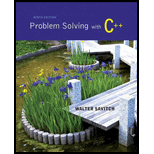
Sorting of ten numbers
Program Plan:
- Include required header file.
- Include required “std” namespace.
- Define main function
- Declare “deque” variable to store the numbers in “double” data type.
- Declare “deque” variable to store the result in “double” data type.
- Declare a variable “values” in “double” data type.
- Display prompt statement.
- Read ten numbers from user and then store in “deque” using “push_back()” function.
- Before sorting, display the ten numbers using “for” loop.
- Then sort the ten numbers using generic “sort” function.
- Finally display the sorted numbers using “for” loop.
The below C++ program is used to sorts the ten “double” numbers in the “deque” using the generic “sort” function.
Explanation of Solution
Program:
//Header file
#include <iostream>
#include <deque>
#include <algorithm>
//Std namespace
using std::cout;
using std::cin;
using std::endl;
using std::deque;
using std::sort;
//Main function
int main()
{
/* Declare deque to store the numbers in "double" type */
deque<double> numbers;
/* Declare deque to iterator */
deque<double>::iterator result;
/* Declare "values" in "double" data type */
double values;
/* Display prompt statement */
cout << "Enter ten numbers" << endl;
/*Read ten numbers */
for(int i = 0; i < 10; i++)
{
cin>>values;
/* Store the ten numbers in deque */
numbers.push_back(values);
}
/* Display statement */
cout << "Before sorting, the ten double numbers are " << endl;
/* Display numbers before sorting */
for(result = numbers.begin(); result != numbers.end();result++)
cout << *result << endl;
/* Sort the numbers in "deque" using "sort" function */
sort(numbers.begin(), numbers.end());
/* Display statement */
cout << "After sorting, the ten double numbers are " << endl;
/* Display sorted numbers */
for(result = numbers.begin(); result != numbers.end();result++)
cout << *result << endl;
return 0;
}
Enter ten numbers
40
30.12
12
10
32.10
54.6
80
15.8
98.4
34
Before sorting, the ten double numbers are
40
30.12
12
10
32.1
54.6
80
15.8
98.4
34
After sorting, the ten double numbers are
10
12
15.8
30.12
32.1
34
40
54.6
80
98.4
Want to see more full solutions like this?
Chapter 18 Solutions
Problem Solving with C++ (9th Edition)
- Ensure you answer the question asked at the end of the document. Do not just paste things without the GNS3 console outputsarrow_forward"Do not use AI tools. Solve the problem by hand on paper only and upload a photo of your handwritten solution."arrow_forward"Do not use AI tools. Solve the problem by hand on paper only and upload a photo of your handwritten solution."arrow_forward
- "Do not use AI tools. Solve the problem by hand on paper only and upload a photo of your handwritten solution."arrow_forward"Do not use AI tools. Solve the problem by hand on paper only and upload a photo of your handwritten solution."arrow_forwardSolve this "Do not use AI tools. Solve the problem by hand on paper only and upload a photo of your handwritten solution."arrow_forward
- "Do not use AI tools. Solve the problem by hand on paper only and upload a photo of your handwritten solution."arrow_forward"Do not use AI tools. Solve the problem by hand on paper only and upload a photo of your handwritten solution."arrow_forwardSpecifications: Part-1Part-1: DescriptionIn this part of the lab you will build a single operation ALU. This ALU will implement a bitwise left rotation. Forthis lab assignment you are not allowed to use Digital's Arithmetic components.IF YOU ARE FOUND USING THEM, YOU WILL RECEIVE A ZERO FOR LAB2!The ALU you will be implementing consists of two 4-bit inputs (named inA and inB) and one 4-bit output (named out). Your ALU must rotate the bits in inA by the amount given by inB (i.e. 0-15).Part-1: User InterfaceYou are provided an interface file lab2_part1.dig; start Part-1 from this file.NOTE: You are not permitted to edit the content inside the dotted lines rectangle. Part-1: ExampleIn the figure above, the input values that we have selected to test are inA = {inA_3, inA_2, inA_1, inA_0} = {0, 1, 0,0} and inB = {inB_3, inB_2, inB_1, inB_0} = {0, 0, 1, 0}. Therefore, we must rotate the bus 0100 bitwise left by00102, or 2 in base 10, to get {0, 0, 0, 1}. Please note that a rotation left is…arrow_forward
 C++ Programming: From Problem Analysis to Program...Computer ScienceISBN:9781337102087Author:D. S. MalikPublisher:Cengage LearningProgramming Logic & Design ComprehensiveComputer ScienceISBN:9781337669405Author:FARRELLPublisher:Cengage
C++ Programming: From Problem Analysis to Program...Computer ScienceISBN:9781337102087Author:D. S. MalikPublisher:Cengage LearningProgramming Logic & Design ComprehensiveComputer ScienceISBN:9781337669405Author:FARRELLPublisher:Cengage EBK JAVA PROGRAMMINGComputer ScienceISBN:9781337671385Author:FARRELLPublisher:CENGAGE LEARNING - CONSIGNMENT
EBK JAVA PROGRAMMINGComputer ScienceISBN:9781337671385Author:FARRELLPublisher:CENGAGE LEARNING - CONSIGNMENT Microsoft Visual C#Computer ScienceISBN:9781337102100Author:Joyce, Farrell.Publisher:Cengage Learning,
Microsoft Visual C#Computer ScienceISBN:9781337102100Author:Joyce, Farrell.Publisher:Cengage Learning, Systems ArchitectureComputer ScienceISBN:9781305080195Author:Stephen D. BurdPublisher:Cengage Learning
Systems ArchitectureComputer ScienceISBN:9781305080195Author:Stephen D. BurdPublisher:Cengage Learning C++ for Engineers and ScientistsComputer ScienceISBN:9781133187844Author:Bronson, Gary J.Publisher:Course Technology Ptr
C++ for Engineers and ScientistsComputer ScienceISBN:9781133187844Author:Bronson, Gary J.Publisher:Course Technology Ptr





